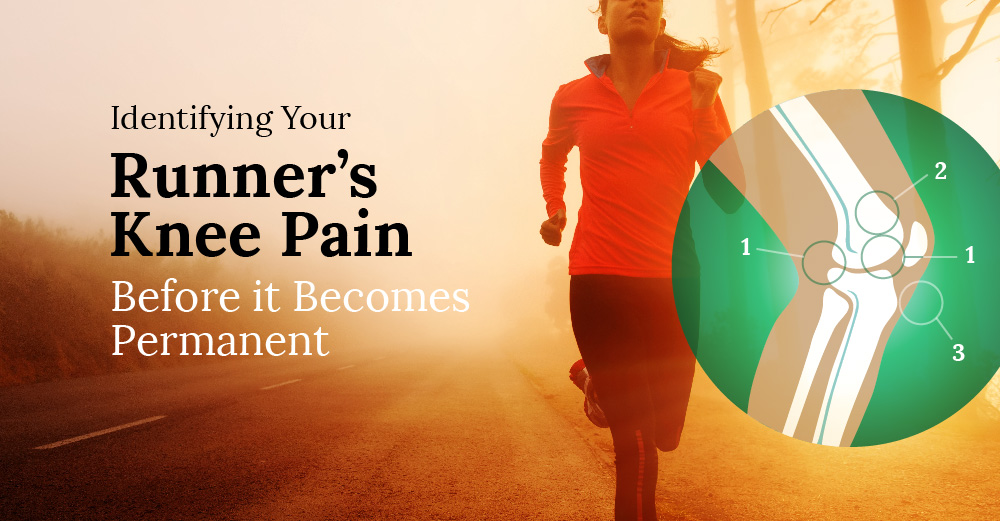Your knee is nothing to take for granted.
And when it starts to hurt, it should be flashing big, blinding warning signs.
Knee pain is nothing to mess around with.
Of course, the first question is when is it a real problem? And when is it just something temporary?
First off, again, don’t take your knees for granted. Any pain you feel – be keenly aware of it, especially if it is localized around a particular area like the knee.
The more you are aware, the more you can notice the signs before the problem becomes a serious injury.
Let’s face it, we can be tough on our knees as runners.
And all too often we think we can just run through the pain. In fact, it’s a badge of honor. No pain, no gain, right?
Like all things, it depends.
There’s that good overall ache when you know you’ve pushed yourself without breaking yourself. Then there is the more specific and focused pain that shows up only in certain areas.
Sometimes it’s dull pain. Sometimes it feels like someone rammed a needle in your knee and is now wrenching it around. If it’s anything more than some temporary muscle soreness, it’s something to pay attention to.
As running coach Jenny Hadfield says…
“Sore legs are one thing, but a sore lower calf is another. Pay extra attention to pin-pointed discomforts, as these can often cause poor running form due to compensation.”
Obviously, but not obviously, prevention is the best option.
Most problems are caused by overuse, improper use, bad form, and unbalanced muscles that affect the area. Yet, even as we say… “I know, I know, prevention, blah blah blah…” we just don’t do it… and later pay for it dearly.
Check out the Unrivaled Guide to Runner’s Knee Pain Relief for everything you need to know to prevent, treat and recover from knee pain.
But you’re probably here because you are already feeling the pain in or around your knee, so let’s dig in to help you understand, identify, and address your knee pain.
Table of Contents
Overview of the Knee »
1. Knee Cap Pain – Runner’s Knee »
2. Sides of the Knee Pain – IT Band Syndrome »
3. Bottom of Knee Cap Pain – Patellar Tendinitis »
4. Knee Arthritis »
5. Meniscus/Cartilage Tear »
When to See a Doctor »
A Quick Overview of the Knee
Here’s the knee in all it’s glory.

Source: Blausen.com staff. “Blausen gallery 2014”. Wikiversity Journal of Medicine. DOI:10.15347/wjm/2014.010. ISSN 20018762.
It’s truly a wonder of the human body. It stays firm yet flexible, cushioning the blows of every step yet being strong in it’s flexibility to keep us stable and moving with great dexterity.
So what happens when it breaks down? Then we need to find out what’s wrong as soon as possible so we can address it before our knees are screaming with every step on a more permanent basis. It’s time to identify, relieve the pain, and heal.
Let’s get to identifying the pain.
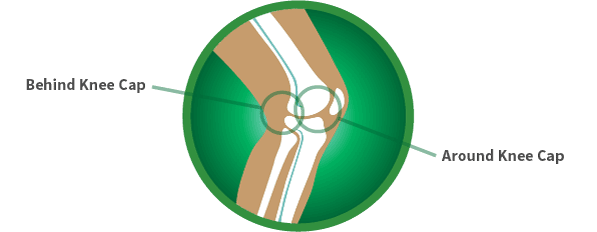
Knee Cap Pain – Runner’s Knee – Patellofemoral Pain Syndrome
One of the most common types of knee pain injury for runners is the dreaded Runner’s Knee, or Patellofemoral Pain Syndrome (PFPS).
The pain you feel is behind or around the knee cap, developing during or after running. It can be worse going up or down stairs.
If left unchecked, it can aggravate into chondromalacia and become a bigger, more persistent problem that will take a lot more time and work to recover from.
To begin with, take some rest. Additional aggravation only worsens the problem, and it will become more and more persistent.
One major contributor is weak quad and/or hip muscles. Remember when I mentioned prevention is the best option? Proper strengthening of quads and hip muscles helps to prevent and recover from this condition.
Michael Rathleff led a systematic review of the research around Patellofemoral Pain (Runner’s Knee) and found deficient hip strength to be a consistent factor. (Thanks to Dr Christian Barton and Running Physio for sharing)
Be sure to check out the Ultimate Guide to Runner’s Knee Pain for exercises and stretches, as well as proper form and recovery plans. And for pain relief, check out how 3 studies reveal the knee pain relief of acupuncture »
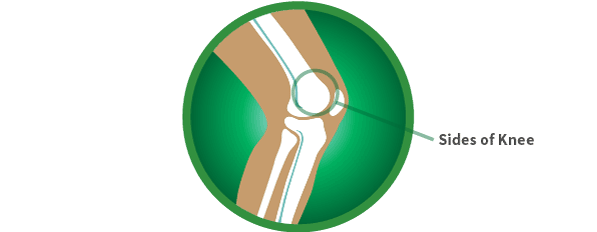
Sides of the Knee Pain – Iliotibial Band Inflammation or Iliotibial Band Syndrome
Another common running knee pain is Iliotibial Band Inflammation (or “IT Band”).
The pain you feel is on the sides of the knee, usually a little above the knee joint, happening after running for a certain distance or time.
This will keep returning on future runs, and get more persistent, so give it plenty of rest and address the underlying problem. Don’t be fooled by the pain disappearing between runs.
Interestingly enough, while this is knee pain, the actual source isn’t as much about the knee as the IT Band – a ligament that runs from hip to shin. It helps stabilize and move the joint, and when tight or inflamed it can cause pain in the knee.
Again, hip weakness can be a contributing factor to IT Band Inflammation knee pain. Also, strengthening the quads and a comprehensive hip and IT Band stretching program will both typically have a positive effect.
Foam rolling self-massage for IT Bands is another common recommendation.
Check out the Ultimate Guide to Runner’s Knee Pain for a full set of resources and exercises to get you back to running.
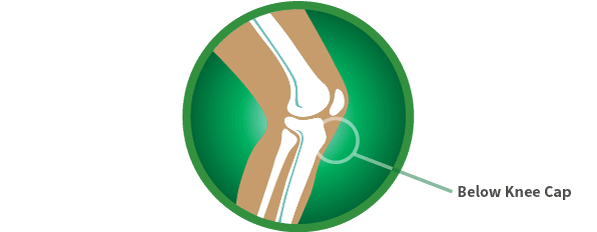
Pain Where the Knee Cap Meets the Shin – Patellar Tendinitis or Patellar Tendinopathy
Another fairly common cause of knee pain for runners, is caused by repetitive strain on the tendon that connects the knee cap to the lower leg bone.
You feel this pain just below the knee cap where it meets the shin. This pain can bleed into your daily activities, and the source of the pain can sometimes be difficult to identify.
Recurring stress causes tears in the microscopic structure of the tendon, and continuing to run only causes more tears. The tears also cause some swelling, which in turn causes pain.
Overuse is the name of the game here.
But other factors like footwear and running surface can contribute to the cause. Improper form and other imbalances in the body can also be contributing factors.
The first thing is to give it full recovery and rest while reducing inflammation, and identify the source of the repetitive abuse. Acupuncture is excellent for helping with this kind of recovery.

Knee Arthritis
The good news is that Arthritis of the knee is shown in recent research to not have any relation to running.
You’ll get it or you won’t.
However, it does affect your running if you get it and is a not uncommon source of knee pain. So we are going to address it.
Arthritis generally involves damage or degeneration of the cartilage and ligaments, depending on what type it is.
How do you know if it’s arthritis? Generally it builds up gradually over time and involves pain and swelling. It can be felt more than just while running. But activity like running can make it flare up.
It can begin to get so stiff and swollen it gets hard to bend the knee, or lock or stick. Rainy weather can increase joint pain, as can getting up after sitting or resting (including mornings).
Your doctor can help identify if and what type of arthritis you may have. And these studies show how you can relieve the pain and swelling with the help of acupuncture.
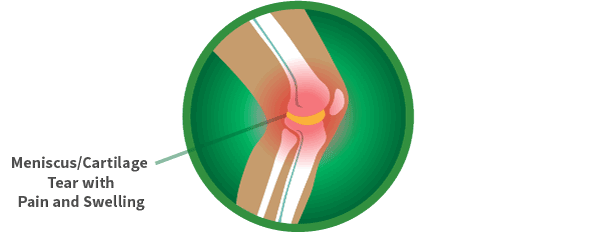
Pain, Swelling, and Maybe “Locking” Sensation – Meniscus/Cartilage Tear
Similar to Arthritis, this physical injury to the meniscus or cartilage inside the knee causes pain and swelling, and can also cause the sensation of “catching” or “locking” sensation in the knee.
See your doctor. Enough said. These issues generally don’t heal on their own.
When to See a Doctor
While being some of the most common, these don’t cover all possibilities of knee pain. Seeing a qualified professional is essential.
Cathy Fieseler, M.D. includes other common conditions:
“Other causes of knee pain include hamstring tendinitis, meniscus tears, arthritis and stress fractures. A sports medicine professional can determine the cause of your symptoms and the best course of treatment.”
We touched on when it’s important to see a doctor, but it’s worth taking a few more moments on the topic.
When in doubt, see a doctor.
When pain repeats, see a doctor.
When pain is not that good muscle ache, see a doctor.
When pain is localized in a certain area, sharp, or doesn’t feel right – see a doctor.
And last but not least, if you are experiencing pain chronically, in recovering from an injury, or in the process of healing from one of the pains above – I recommend some help using acupuncture in a runner specific treatment plan.
Acupuncture is shown to be particularly effective on pain management, and can help your recovery and healing. Find a licensed practitioner in your area, or in Seattle you can come in to our offices near Capitol Hill to see what I can do to help you heal, find relief from pain, and get back to running.

